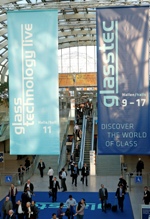Post Time:Oct 24,2012Classify:Industry NewsView:399
From new coatings to new interlayers, glasstec exhibitors featured a number of developments for architectural glazingThe show is taking place this week in Dusseldorf, Germany, and companiesfrom around the world are displaying some of their latest products.
Eastman, which acquired Solutia earlier this year, featured a number of products for laminated glass applications including Saflex DG, its new interlayer material designed for structural glazing. The product drew a large crowd and lots of interest, according to Doug Marren, architectural business manager of Americas for advanced interlayers. Marren explained that the new material is stiffer than traditional PVB so laminated applications can sustain higher uniform loads with the same glass thickness. He added that the glass thickness can also be reduced and still achieve the same loading.
In addition, Eastman is also in the process of launching new solar interlayers for the architectural market. The line was introduced last year for the automotive market and offers UVA and UVE blocking features thanks to nano particles that are mixed into the interlayer.
Also featuring a line of interlayer choices, Bridgestone, which is based in Germany, offered decorative selections that can include imagery printed onto PET film that's laminated to glass with EVA film. Alexander Weibgarber, technical sales engineer, explained its material can also be laminated with a range of materials including stone, fabrics, etc. He said the EVA is created to offer high-quality durability and will not bubble or yellow over time.
On the coatings side, Ferro featured its S1de ONE enamels, which are new for the United States, but have been in use in Europe for some time. Phil Maitland, global marketing and business development manager, glass systems, explained that most enamels are applied on the second surface as they do not have the weather-resistant features to be used on the external side one. Now, however, with his company's new system the enamel can be used on the first surface.
"Architects like this because they can build texture, create a matte effect, etc… because you're not seeing the glass, but what's on the glass," said Maitland. "And now we're starting to see this in the United States."
Source: www.usgnn.comAuthor: shangyi
PrevPrice of Manual Sandblasting Machine on October 23, 2012 from China Glass Machine
Glaston Leader Explains Move to Less Brands, Less MachineryNext